Turnout was low in the first County elections
Review related to topics:
Population and societyThe voting turnout in the County elections 2022 was 47.5 per cent. Statistics Finland's data indicate that especially young people's voting turnout remained low.
Statistics Finland’s review examines persons entitled to vote and those who voted in the County elections 2022 according to various background factors. The data are based on the Ministry of Justice's voting register and Statistics Finland's unit-level data. The review examines, on the one hand, all persons entitled to vote and advance voters in the County elections 2022 and, on the other hand, persons entitled to vote and those who voted in the municipalities and voting districts where an electronic voting register was used in the 2022 elections.
The electronic voting register enables examination of voting turnout for votes cast on the election day. These data provide a complete picture of voting turnout as they can help take into account those who did not vote. This is not possible for the data containing only advance voters. In this review, advance voters refer to all persons that voted in advance throughout the country and all who voted refer to both advance voters and those who voted on the election day in the above-mentioned areas.
The data presented in the review concerning all who voted do not cover the entire country or all persons entitled to vote. In this review, all who voted refer to those who voted in those areas on which data were available. The data presented in this review have not been edited in any way, for example, by weighting the data based on background factors, but the breakdowns are presented as they are in the data. In other words, the data presented on all who voted in a particular area only apply to the municipalities, voting districts and persons entitled to vote for which data were available.
Analysed data
The analyses of the review include two separate but partly overlapping voter groups. The following terms are used for these voter groups in the text, tables and figures of the review:
1st group: Advance voters
- all persons who voted in advance in the County elections
- throughout the country
2nd group: All who voted in the areas
- both advance voters and persons who voted on the election day
- in the voting districts that used the electronic voting register
The voter groups used in the review are not mutually exclusive. The advance voters of the entire country also include the persons entitled to vote who voted in advance in the above-mentioned areas. All who voted in the areas also include all persons that voted in advance in those particular areas. Thus, the group “advance voters” depicts, just like the name suggests, persons entitled to vote who voted in advance in the entire country, and the group “all who voted in the areas” covers persons who voted on the election day and in advance in a limited number of voting districts.
There were 3,927,728 persons entitled to vote in the County elections 2022. Of these persons entitled to vote, 1,041,794, or 26.5 per cent of all persons entitled to vote, voted in advance. The voting districts where data on voting on the actual election day are available had 2,030,418 persons entitled to vote. So complete voting data are available for 51.7 per cent of persons entitled to vote.
All unit-level background data cannot be linked to all persons entitled to vote. For individual background variables used in the analyses the numbers of persons entitled to vote can be lower than the above-mentioned numbers. In practice, this is visible, for example, in that the distributions presented in the figures and tables may vary slightly by background variable.
Data coverage
The voting districts and municipalities for which all voting data were received are not divided entirely equally on the level of the whole country. Data on voting on the actual election day were available from 156 municipalities, from 112 municipalities for all voting districts and from some of voting districts for 44 municipalities.
However, the coverage of the data varies by wellbeing services county. The most comprehensive data were available in the wellbeing services county of Vantaa and Kerava, 100 per cent of persons entitled to vote. The coverage of the electronic voting register was weakest in the wellbeing services county of South Karelia, 3.6 per cent of persons entitled to vote.
The data obtained from the areas covered by the electronic voting register correspond quite well to all persons entitled to vote. In the examined areas, persons entitled to vote do not differ from all persons entitled to vote in terms of the key socio-economic background factors. Differences in the age, sex, education, main type of activity and language of persons entitled to vote are marginal between the areas and the whole country. Support for the parties in the County elections is also very similar in the whole country and in the examined areas.
| Persons entitled to vote, whole country | Voting areas with complete voting data | |
|---|---|---|
| Age, average | 51,5 | 50,9 |
| Sex, men (%) | 49,3 | 49,3 |
| Income, median (EUR) | 22 281,0 | 22 259,0 |
| Education: lower secondary (%) | 23,8 | 23,5 |
| Education: upper secondary (%) | 44,2 | 44,4 |
| Education: lowest tertiary (%) | 9,5 | 9,4 |
| Education: lower tertiary (%) | 12,2 | 12,6 |
| Education: higher university, doctorate (%) | 10,3 | 10,1 |
| Employed (%) | 50,0 | 50,3 |
| Unemployed (%) | 7,6 | 7,7 |
| Students (%) | 6,5 | 6,9 |
| Pensioners (%) | 32,0 | 31,1 |
| Other inactive population (%) | 3,6 | 3,6 |
| Finnish-speaking (%) | 89,2 | 89,3 |
| Swedish-speaking (%) | 4,5 | 4,5 |
| Other language speaking (%) | 6,3 | 6,3 |
| Social Democrats, support (%) | 19,3 | 19,7 |
| Finns Party, support (%) | 11,1 | 10,9 |
| Coalition Party, support (%) | 21,6 | 20,6 |
| Centre Party, support (%) | 19,2 | 19,5 |
| Green League, support (%) | 7,4 | 7,8 |
| Left Alliance, support (%) | 8,0 | 8,6 |
| Swedish People’s Party, support (%) | 4,9 | 4,8 |
| Christian Democrats, support (%) | 4,2 | 4,0 |
| Movement Now, support (%) | 1,8 | 1,6 |
| Others, support (%) | 1,1 | 1,1 |
The factors presented in this Section should be considered when generalising the data obtained with the electronic voting register on all who voted in the areas to relate to the whole country.
Young men are passive voters
In the County elections 2022, a total of 1,041,794 persons entitled to vote voted in advance, which represents 26.5 per cent of all persons entitled to vote living in Finland. The advance voting percentage reported by Statistics Finland in the published election results of the County elections is 55.8 per cent. The advance voting percentage is derived by calculating the share of advance voters among those having voted. In this review, persons who voted are examined in relation to persons entitled to vote, so the percentages given are lower than the advance voting percentage.
In the voting districts where all voting data were available, a total of 47.0 per cent of persons entitled to vote cast their vote.
Age clearly has an impact on voting turnout. Advance voting was most common among persons aged 74, of whom 46.2 per cent voted in advance. The share of advance voters falls under 30 per cent among persons aged 86.
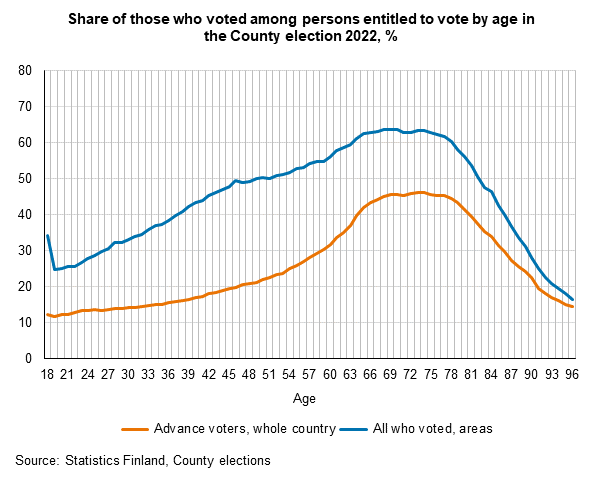
The data on the share of all who voted among persons entitled to vote obtained with the help of the electronic voting register provides a more comprehensive picture of the occurrence than that of advance voting. The voting percentage of persons aged 18 was 34.2 per cent in these areas in the 2022 elections. The voting percentage dropped to 25.1 per cent in the group of persons aged 20. After this, the voting percentage grew quite evenly to 49.4 per cent among persons aged 46. The voting percentage was at its highest in the group of persons aged 70 (63.7%). The voting percentage fell under 60 per cent in the group of those aged 79, while the level of those aged 20 is below the age group of those aged 91.
Women voted more actively than men in advance both in the whole country and in the areas, apart from the oldest examined age group. In the whole country 28.9 per cent of women entitled to vote voted in advance, 4.8 percentage points more than men.
The voting percentage that takes into account all persons who voted is also higher for women. In the areas 49.5 per cent of women voted, which was 5.0 percentage points higher than for men. Examined by age group, women voted more actively than men in all age groups except for persons aged 75 or over. The biggest difference in voting activity between the sexes was found in the youngest age groups. Women's voting percentage was nearly ten percentage points higher in the 20 to 24 age group than men's.
| Total | Men | Women | ||||
|---|---|---|---|---|---|---|
| Advance voters, whole country | All who voted, areas | Advance voters, whole country | All who voted, areas | Advance voters, whole country | All who voted, areas | |
| Total | 26.5 | 47.0 | 24.1 | 44.5 | 28.9 | 49.5 |
| 18-19 | 12.0 | 29.6 | 9.8 | 24.9 | 14.4 | 34.4 |
| 20-24 | 12.9 | 26.2 | 9.5 | 21.5 | 16.6 | 31.2 |
| 25-34 | 14.2 | 32.8 | 12.0 | 29.0 | 16.7 | 37.0 |
| 35-44 | 16.9 | 42.4 | 14.8 | 38.9 | 19.2 | 46.2 |
| 45-54 | 21.9 | 49.9 | 19.6 | 47.0 | 24.3 | 52.9 |
| 55-64 | 31.8 | 56.2 | 28.8 | 53.8 | 34.7 | 58.6 |
| 65-74 | 44.9 | 63.2 | 43.0 | 62.1 | 46.7 | 64.2 |
| 75- | 37.3 | 50.3 | 40.3 | 55.4 | 35.2 | 46.8 |
High education increased the probability of voting
Of the groups of main type of activity, pensioners were most advance voters in the whole country (31.7%). The number of employed persons was slightly lower among advance voters (28.4 per cent). Among advance voters, the number of employed persons was lower and that of pensioners higher than among all persons entitled to vote. In other groups of main type of activity, the share of advance voters was relatively smaller than among all persons entitled to vote.
The share of all who voted belonging to all main type of activity groups remained below the relative size of the groups among all persons entitled to vote.
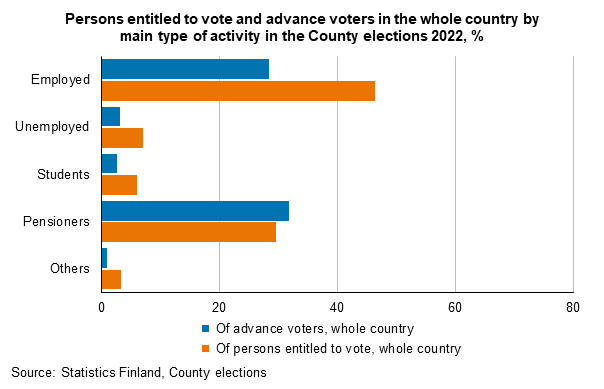
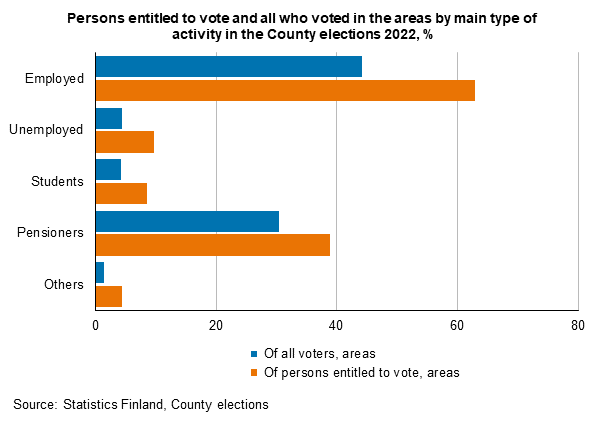
High education increases the probability of voting. Persons entitled to vote with lowest tertiary or higher education voted in advance more than average in the County elections. This is also visible for all who voted in the areas, the voting percentage of persons with higher tertiary or doctorate level education was 25.5 percentage points higher than among all persons entitled to vote and 40.5 percentage points higher than among all persons entitled to vote with only basic level qualifications.
In nearly all educational groups voting turnout grew with age, apart from the youngest and oldest examined age groups. The voting turnout of over 80 per cent was reached in the regional elections only among 65 to 74-year-olds with highest tertiary level degrees.
When interpreting Table 2 it should be noted that lowest tertiary level qualifications decrease in the population and no new qualifications are completed in Finland in this category, so the age structure of the educational group differs clearly from other groups. Lowest tertiary level education covers qualifications above upper secondary level that are not university of applied sciences degrees.
| Total | Lower secondary | Upper secondary | Lowest tertiary | Lower tertiary | Higher tertiary, doctorate | ||
|---|---|---|---|---|---|---|---|
| Total | All who voted, areas | 47,0 | 32,0 | 41,5 | 67,0 | 58,8 | 72,5 |
| Advance voters, whole country | 26,5 | 20,1 | 22,7 | 42,2 | 29,8 | 39,4 | |
| 18-24 | All who voted, areas | 27,1 | 23,8 | 28,9 | data missing | 49,5 | data missing |
| Advance voters, whole country | 12,6 | 10,0 | 14,1 | data missing | 29,8 | data missing | |
| 25-34 | All who voted, areas | 32,8 | 10,8 | 27,0 | 18,5 | 48,9 | 61,6 |
| Advance voters, whole country | 14,2 | 5,2 | 10,4 | 9,7 | 22,1 | 31,4 | |
| 35-44 | All who voted, areas | 42,4 | 15,3 | 34,5 | 44,8 | 54,7 | 66,3 |
| Advance voters, whole country | 16,9 | 6,5 | 12,9 | 17,4 | 21,6 | 28,5 | |
| 45-54 | All who voted, areas | 49,9 | 21,7 | 41,4 | 58,9 | 62,2 | 74,2 |
| Advance voters, whole country | 21,9 | 9,7 | 17,9 | 26,3 | 26,7 | 33,6 | |
| 55-64 | All who voted, areas | 56,2 | 33,3 | 50,7 | 67,1 | 70,0 | 79,3 |
| Advance voters, whole country | 31,8 | 18,4 | 28,3 | 38,8 | 38,9 | 46,0 | |
| 65-74 | All who voted, areas | 63,2 | 49,4 | 61,1 | 75,7 | 79,5 | 83,7 |
| Advance voters, whole country | 44,9 | 33,6 | 42,9 | 55,8 | 58,9 | 63,5 | |
| 75- | All who voted, areas | 50,3 | 40,4 | 53,7 | 66,4 | 70,0 | 76,0 |
| Advance voters, whole country | 37,3 | 29,1 | 39,4 | 51,0 | 54,8 | 60,6 | |
The family status of persons who voted is examined by means of limited family status groups. Attention is paid to married or cohabiting couples and those without a family, the number of children and the age of persons entitled to vote.
Those cohabiting or married voted in the areas clearly more than those without a family, the voting percentage was nearly 17 percentage points higher than that of those without a family. The voting percentage of those cohabiting or married with children aged under 18 was over nine per cent lower than that of those whose children were aged over 18. The voting turnout of parents of one-parent families remained at 34.7 per cent.
When examining the voting turnout of young people aged 18 to 24, we can see that the voting turnout of those living at home (with their parents) was slightly higher than of those of the same age not belonging to families. Those not belonging to a family include both those living alone and with another person or other persons. The difference in the groups’ voting turnout was 3.4 percentage points.
An age group specific examination of all who voted does not significantly change the picture of the effect of family status. As a rule, the voting percentage grew in all family status groups by age, apart from the oldest age group of people aged 75 and over. For the family status, the group “Other” includes those aged over 24 living at home, parents of one-parent families living with their adult child, the institutional population and unclassified persons and those whose family status is unknown.
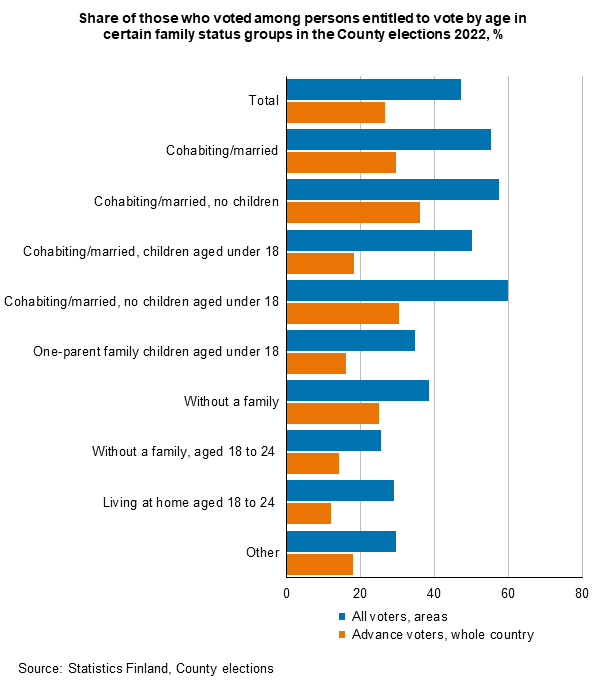
| Total | Cohabiting/married | Cohabiting/married, no children | Cohabiting/married, children aged under 18 | Cohabiting/married, no children aged under 18 | One-parent family, children aged under 18 | Without a family | Other | ||
|---|---|---|---|---|---|---|---|---|---|
| Total | All who voted, areas | 47,1 | 55,3 | 57,5 | 50,3 | 59,9 | 34,7 | 38,5 | 29,7 |
| Advance voters, whole country | 26,6 | 29,7 | 36,0 | 18,4 | 30,4 | 16,0 | 25,1 | 18,1 | |
| 18-24 | All who voted, areas | 27,2 | 27,2 | 28,1 | 21,3 | data missing | 9,2 | 25,7 | 11,5 |
| Advance voters, whole country | 12,6 | 11,8 | 12,6 | 6,3 | data missing | 4,0 | 14,3 | 7,1 | |
| 25-34 | All who voted, areas | 33,0 | 38,5 | 39,6 | 37,2 | data missing | 19,0 | 28,4 | 23,5 |
| Advance voters, whole country | 14,3 | 15,0 | 17,1 | 12,8 | data missing | 8,1 | 14,3 | 11,9 | |
| 35-44 | All who voted, areas | 42,6 | 48,0 | 42,9 | 49,3 | 35,0 | 33,8 | 32,1 | 24,6 |
| Advance voters, whole country | 17,0 | 17,6 | 18,6 | 17,3 | 12,6 | 14,9 | 16,4 | 14,2 | |
| 45-54 | All who voted, areas | 50,1 | 55,8 | 49,4 | 59,3 | 55,4 | 44,5 | 37,5 | 34,0 |
| Advance voters, whole country | 22,0 | 22,7 | 23,5 | 22,1 | 23,5 | 21,0 | 20,6 | 19,2 | |
| 55-64 | All who voted, areas | 56,3 | 62,3 | 62,0 | 63,0 | 63,6 | 50,2 | 45,3 | 41,0 |
| Advance voters, whole country | 31,8 | 33,8 | 35,3 | 26,9 | 31,1 | 25,4 | 28,7 | 25,0 | |
| 65-74 | All who voted, areas | 63,2 | 69,2 | 69,5 | 63,2 | 64,9 | 55,6 | 52,9 | 42,7 |
| Advance voters, whole country | 45,0 | 48,6 | 49,2 | 34,5 | 40,8 | 32,8 | 38,8 | 31,0 | |
| 75- | All who voted, areas | 50,3 | 60,8 | 61,2 | data missing | 52,1 | data missing | 42,0 | 23,3 |
| Advance voters, whole country | 37,3 | 44,4 | 44,9 | data missing | 34,2 | data missing | 31,7 | 17,8 | |
Voting more common in higher income brackets
The income level of those who voted and of persons entitled to vote is examined with the help of disposable monetary income. Income data derive from the latest taxation data from 2020. Disposable monetary income refers to monetary income after taxes. This consist of earned income, property income, benefits in kind and transfer income.
In the data of the review, the income of persons entitled to vote is divided into deciles. Income deciles are derived by arranging persons entitled to vote by income and by dividing the group into ten equal parts. The groups formed in this way each have around 391,000 persons entitled to vote for all persons entitled to vote in the whole country. In areas from which data were received on voting on the election day as well, the groups have around 202,000 persons entitled to vote each.
For the whole country, income data are missing for some 14,000 persons entitled to vote. In the data for areas containing election day votes, the income level was missing for some 7,600 persons entitled to vote. The median for the disposable income of all persons entitled to vote was around EUR 22,300, in the examined areas the corresponding median income was also EUR 22,300. The disposable income of persons entitled to vote in the whole country belonging to the highest income decile was at least EUR 40,353 and in the examined areas it was EUR 39,926 per year. The income for those belonging to the lowest income decile was EUR 10,162 for the whole country and EUR 10,087 per year in the areas.
| Advance voters, whole country | All who voted, areas | |
|---|---|---|
| 1st decile | 0,0 | 0,0 |
| 2nd decile | 10 162,0 | 10 087,0 |
| 3rd decile | 13 951,0 | 13 958,0 |
| 4th decile | 16 476,0 | 16 506,0 |
| 5th decile | 19 150,0 | 19 158,0 |
| 6th decile | 22 281,0 | 22 259,0 |
| 7th decile | 25 420,0 | 25 373,0 |
| 8th decile | 28 619,0 | 28 529,0 |
| 9th decile | 32 851,0 | 32 676,0 |
| 10th decile | 40 352,0 | 39 925,0 |
On the level of the whole country, the level of income did not have much effect on advance voting. In the lowest income deciles, advance voting is relatively lower and in the highest deciles higher than in the other income brackets. No great changes took place in the rate of advance voting from the third income decile to the eighth decile.
When examining all who voted in the areas, the effect of income on voting turnout was considerably more evident. As a rule, voting was more common in higher income groups than in lower income groups. In all, 65.7 per cent of those belonging to the highest income decile voted. By contrast, the voting turnout remained at 29.5 per cent in the lowest income decile. Thus, the difference between the voting turnout of the lowest and highest income earners was over 36 percentage points.
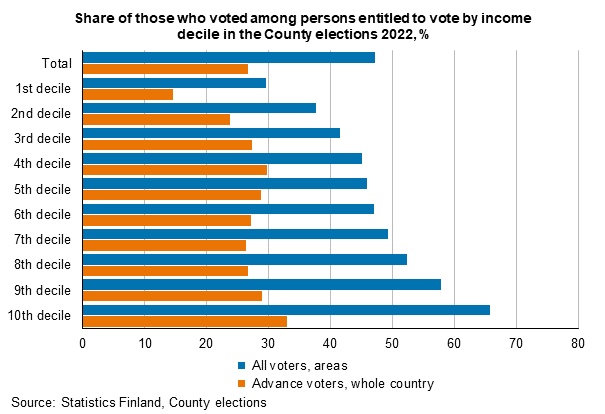
The occupations of those entitled to vote is examined with the Classification of Occupations. The occupation data used are from 2019. The occupation is determined on the last day of the year for persons who, based on their main type of activity, are employed. The occupation data for those entitled to vote in the 2022 elections are available for around 1,970,000 persons entitled to vote. In the examined areas, the corresponding data is available for some 1,020,000 persons entitled to vote.
The voting turnout for all persons entitled to vote for whom occupation data is available in the examined areas was 49.0 per cent. Among occupational groups, professionals had the highest voting turnout, 67.5 per cent. The over 60 per cent level was also exceeded for managers. The voting percentage was lower than average in different employee groups apart from clerical support workers.
Measured by occupational group, voting turnout was lowest in elementary occupations, where voting turnout was 30.2 per cent, which is over 19 percentage points below the average of occupational groups. The elementary occupations group includes auxiliary, routine-like jobs that require only little education.
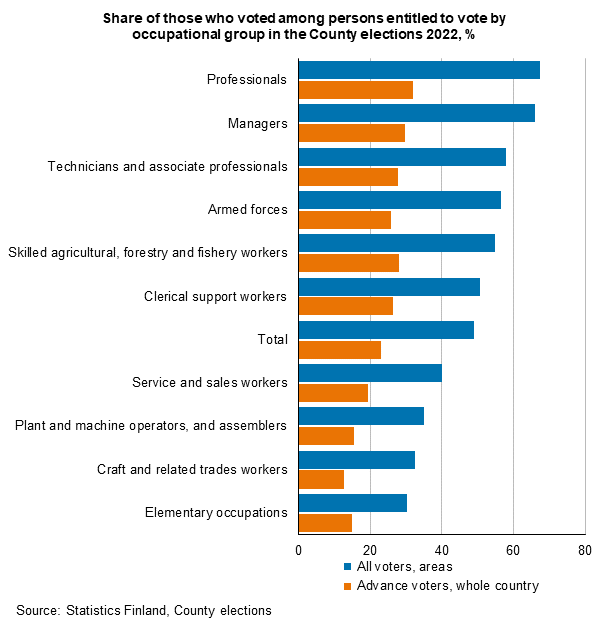
Voting turnout of persons with foreign background was low
The background of persons entitled to vote and persons who voted is viewed by means of language and origin. Voting turnout for persons with national languages as their native language was higher among those who voted in the areas than for all persons entitled to vote. In the areas, 1.8 percentage points more of Finnish and Sami speakers and 12.0 percentage points more of Swedish speakers voted compared to all persons entitled to vote.
In the County elections, the right to vote is tied to residence, that is, there are more persons speaking other than national language as their native language entitled to vote than in the Parliamentary elections, for example. Of all persons entitled to vote, 89.2 per cent were Finnish or Sami-speaking, 4.5 per cent Swedish-speaking and 6.3 per cent other language speakers. In areas where information was obtained on all who voted, the language distribution of the persons entitled to vote corresponds to all persons entitled to vote.
| Total | Men | Women | ||||
|---|---|---|---|---|---|---|
| Advance voters, whole country | All who voted, areas | Advance voters, whole country | All who voted, areas | Advance voters, whole country | All who voted, areas | |
| Total | 26,5 | 47,0 | 24,1 | 44,5 | 28,9 | 49,5 |
| Finnish, Sami | 27,8 | 48,8 | 25,3 | 46,3 | 30,2 | 51,1 |
| Swedish | 29,6 | 59,0 | 26,5 | 56,1 | 32,7 | 61,9 |
| Other language | 6,8 | 13,5 | 6,6 | 12,6 | 7,0 | 14,5 |
The voting turnout of foreign-language speakers was clearly lower than for those speaking national languages. Of all foreign-language speakers, 6.8 per cent voted in advance in the whole country. Correspondingly, among all who voted in the areas, 13.5 per cent of foreign-language speakers voted, which was 33 percentage points fewer than for all persons entitled to vote.
A more detailed examination of the voting turnout of different language groups shows that the highest voting percentage among all votes cast in the areas was found among Swedish speakers (59.0%). Correspondingly, the voting percentage of Finnish and Sami speakers was 48.8 per cent. Figure 7 includes the largest language groups measured by absolute numbers in the areas for which data were also available for election day voting. With this limitation, the voting percentage of foreign-language speakers was highest for German speakers, 37.9 per cent. The voting percentage of other language groups was clearly under 30 per cent.
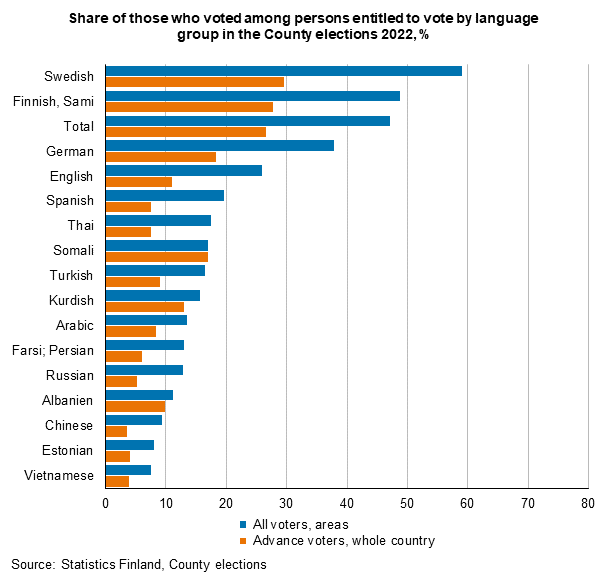
Examined by age group and origin, young people’s voting turnout was lower than in older age groups both among persons of Finnish background and of foreign background. This is visible both among advance voters in the whole country and all who voted in the areas. For all who voted in the areas, the difference between voting turnout among persons of Finnish and foreign background was around 35 percentage points. The voting turnout of persons with foreign background was under 30 per cent in all except the oldest examined age group.
| Total population | Persons with Finnish background | Persons with foreign background | ||||
|---|---|---|---|---|---|---|
| Advance voters, whole country | All who voted, areas | Advance voters, whole country | All who voted, areas | Advance voters, whole country | All who voted, areas | |
| Total | 26,5 | 47,0 | 27,9 | 49,2 | 7,2 | 14,0 |
| 18-24 | 12,6 | 27,1 | 13,2 | 28,4 | 5,2 | 8,7 |
| 25-34 | 14,2 | 32,8 | 15,3 | 35,6 | 5,2 | 9,4 |
| 35-44 | 16,9 | 42,4 | 18,4 | 46,2 | 5,9 | 13,0 |
| 45-54 | 21,9 | 49,9 | 23,2 | 52,8 | 7,2 | 16,2 |
| 55-64 | 31,8 | 56,2 | 32,8 | 57,9 | 9,6 | 19,4 |
| 65-74 | 44,9 | 63,2 | 45,6 | 63,9 | 15,3 | 26,3 |
| 75- | 37,3 | 50,3 | 37,5 | 50,6 | 19,8 | 30,0 |
Database tables
Pick the data you need into tables, view the data as graphs, or download the data for your use.
- Sex
- Wellbeing services county and munincipal type
- Sex of person entitled to vote
- Wellbeing services county and munincipal type
- Sex of person entitled to vote
- Voting place
Future releases
Documentation
Description of the production, used methods and quality of the statistics.
Go to documentation of the statistics